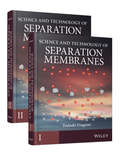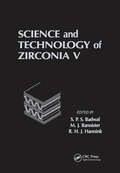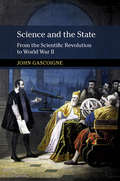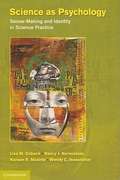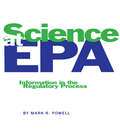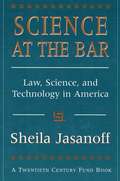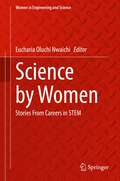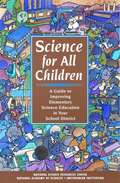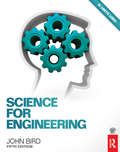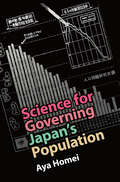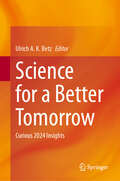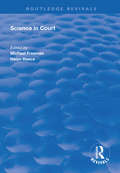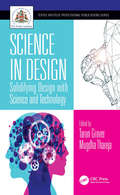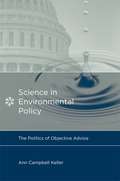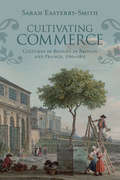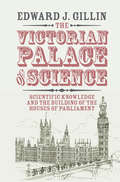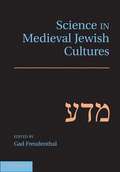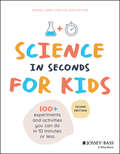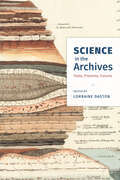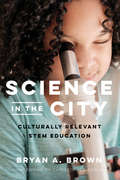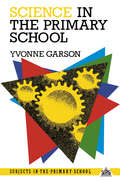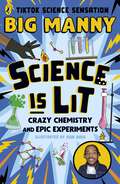- Table View
- List View
Science and Technology of Separation Membranes 2 Vol Set
by Tadashi UragamiOffers a comprehensive overview of membrane science and technology from a single source Written by a renowned author with more than 40 years’ experience in membrane science and technology, and polymer science Covers all major current applications of membrane technology in two definitive volumes Includes academic analyses, applications and practical problems for each existing membrane technology Includes novel applications such as membrane reactors, hybrid systems and optical resolution as well as membrane fuel cells
Science and Technology of Zirconia V
by M., BannisterThis book is based on the Fifth International Conference that was held on 16-21 August, 1992 in Melbourne, Australia, in conjunction with AUSTCERAM 92. It demonstrates that the field of Zirconia ceramics remains one of scientific challenge and technical attraction.
Science and the State: From the Scientific Revolution to World War II (New Approaches to the History of Science and Medicine)
by John GascoigneWas it coincidence that the modern state and modern science arose at the same time? This overview of the relations of science and state from the Scientific Revolution to World War II explores this issue, synthesising a range of approaches from history and political theory. John Gascoigne argues the case for an ongoing mutual dependence of the state and science in ways which have promoted the consolidation of both. Drawing on a wide body of scholarship, he shows how the changing functions of the state have brought a wider engagement with science, while the possibilities that science make available have increased the authority of the state along with its prowess in war. At the end of World War II, the alliance between science and state was securely established and, Gascoigne argues, is still firmly embodied in the post-war world.
Science as Psychology
by Lisa M. Osbeck Nancy J. Nersessian Kareen R. Malone Wendy C. NewstetterScience as Psychology reveals the complexity and richness of rationality by demonstrating how social relationships, emotion, culture and identity, are implicated in the problem-solving practices of laboratory scientists. The authors gather and analyze interview and observational data from innovation-focused laboratories in the engineering sciences to show how the complex practices of laboratory research scientists provide rich psychological insights, and how a better understanding of science practice facilitates understanding of human beings more generally. The study focuses not on dismantling the rational core of scientific practice, but on illustrating how social, personal and cognitive processes are intricately woven together in scientific thinking. The authors argue that this characterization addresses the integration problem in science studies - how to characterize the fluid entanglements of cognitive, affective, material, cultural and other dimensions of discovery and problem solving. The book is thus a contribution to science studies, the psychology of science and general psychology.
Science at EPA: Information in the Regulatory Process
by Mark R. PowellThe U.S. Environmental Protection Agency was created to protect public health and the environment, and it has traditionally emphasized its regulatory mission over its scientific mission. Yet for environmental policy to be credible with the public and policymakers, EPA's actions must have a sound basis in science. In Science at EPA, Mark Powell offers detailed case studies that map the origins, flow, and impact of scientific information in eight EPA decisions involving the agency's major statutory programs. Drawing on extensive research and interviews, he provides the most comprehensive examination available on the acquisition and use of science in environmental regulation. Powell describes the key obstacles to the practical, efficient, and effective acquisition and use of knowledge in what is a crucial, but complex endeavor. His book is an essential contribution for practitioners, scholars and students, and citizens who are determined to protect our environment rationally and effectively.
Science at the Bar: Law, Science, and Technology in America (Twentieth Century Fund Books/Reports/Studies #9)
by Sheila JasanoffIssues spawned by the headlong pace of developments in science and technology fill the courts. How should we deal with frozen embryos and leaky implants, dangerous chemicals, DNA fingerprints, and genetically engineered animals? The realm of the law, to which beleaguered people look for answers, is sometimes at a loss--constrained by its own assumptions and practices, Sheila Jasanoff suggests. This book exposes American law's long-standing involvement in constructing, propagating, and perpetuating a variety of myths about science and technology. Science at the Bar is the first book to examine in detail how two powerful American institutions--both seekers after truth--interact with each other. Looking at cases involving product liability, medical malpractice, toxic torts, genetic engineering, and life and death, Jasanoff argues that the courts do not simply depend on scientific findings for guidance--they actually influence the production of science and technology at many different levels. Research is conducted and interpreted to answer legal questions. Experts are selected to be credible on the witness stand. Products are redesigned to reduce the risk of lawsuits. At the same time the courts emerge here as democratizing agents in disputes over the control and deployment of new technologies, advancing and sustaining a public dialogue about the limits of expertise. Jasanoff shows how positivistic views of science and the law often prevent courts from realizing their full potential as centers for a progressive critique of science and technology. With its lucid analysis of both scientific and legal modes of reasoning, and its recommendations for scholars and policymakers, this book will be an indispensable resource for anyone who hopes to understand the changing configurations of science, technology, and the law in our litigious society.
Science by Women: Stories From Careers in STEM (Women in Engineering and Science)
by Eucharia Oluchi NwaichiThis book provides a roadmap for those embarking on a career in STEM, whether in the research or industry realms. Focusing on paths taken by women, the contributors lend their stories, tips and tricks, and hardships they faced entering into fields historically dominated by men. The authors provide practical advice, highlighting soft skills that are not often taught as modules in the classroom. Topics include research collaborations, performance enhancement, the gender lens in research design and development, imposter syndrome felt by many women in science, ethics in science, scaling feminine leadership, being an influencer as a science leader, and time and resources optimization for career advancement in science from resource-poor settings. Others interested in science and its impacts on society will also find the book informative and timely. As an important part of the Organization for Women in Science in the Developing World (OWSD), University of Port Harcourt Branch Book project, the work hopes to inspire women and men, girls and boys to enter and apply themselves to secure the future in STEM.
Science for All Children: A Guide to Improving Elementary Science Education in Your School District
by National Academy of Sciences Staff Smithsonian Institution StaffRemember the first time you planted a seed and watched it sprout? Or explored how a magnet attracted a nail? If these questions bring back memories of joy and wonder, then you understand the idea behind inquiry-based science--an approach to science education that challenges children to ask questions, solve problems, and develop scientific skills as well as gain knowledge. Inquiry-based science is based on research and experience, both of which confirm that children learn science best when they engage in hands-on science activities rather than read from a textbook.The recent National Science Education Standards prepared by the National Research Council call for a revolution in science education. They stress that the science taught must be based on active inquiry and that science should become a core activity in every grade, starting in kindergarten. This easy-to-read and practical book shows how to bring about the changes recommended in the standards. It provides guidelines for planning and implementing an inquiry-based science program in any school district.The book is divided into three parts. "Building a Foundation for Change," presents a rationale for inquiry-based science and describes how teaching through inquiry supports the way children naturally learn. It concludes with basic guidelines for planning a program.School administrators, teachers, and parents will be especially interested in the second part, "The Nuts and Bolts of Change." This section describes the five building blocks of an elementary science program: Community and administrative support. A developmentally appropriate curriculum. Opportunities for professional development. Materials support. Appropriate assessment tools. Together, these five elements provide a working model of how to implement hands-on science.The third part, "Inquiry-Centered Science in Practice," presents profiles of the successful inquiry-based science programs in districts nationwide. These profiles show how the principles of hands-on science can be adapted to different school settings.If you want to improve the way science is taught in the elementary schools in your community, Science for All Children is an indispensable resource.
Science for Engineering, 5th ed
by John BirdA practical introduction to the engineering science required for engineering study and practice. Science for Engineering is an introductory textbook that assumes no prior background in engineering. This new edition covers the fundamental scientific knowledge that all trainee engineers must acquire in order to pass their exams, and has been brought fully in line with the compulsory science and mathematics units in the new engineering course specifications. John Bird focuses upon engineering examples, enabling students to develop a sound understanding of engineering systems in terms of the basic laws and principles. This book includes over 580 worked examples, 1300 further problems, 425 multiple choice questions (with answers), and contains sections covering the mathematics that students will require within their engineering studies, mechanical applications, electrical applications and engineering systems. Colour layout helps navigation and highlights key learning points, formulae and exercises Understanding can be tested with the 580 worked examples, 1300 further problems and 425 multiple choice questions contained within the book Focuses on real-world situations and examples in order to maximise relevance to the student reader This book is supported by a companion website of materials that can be found at www.routledge/cw/bird, this resource including fully worked solutions of all the further problems for students to access for the first time, and the full solutions and marking schemes for the revision tests found within the book for lecturers/instructors use. In addition, all 433 illustrations will be available for downloading by staff..
Science for Governing Japan's Population (Science in History)
by Aya HomeiTwenty-first-century Japan is known for the world's most aged population. Faced with this challenge, Japan has been a pioneer in using science to find ways of managing a declining birth rate. Science for Governing Japan's Population considers the question of why these population phenomena have been seen as problematic. What roles have population experts played in turning this demographic trend into a government concern? Aya Homei examines the medico-scientific fields around the notion of population that developed in Japan from the 1860s to the 1960s, analyzing the role of the population experts in the government's effort to manage its population. She argues that the formation of population sciences in modern Japan had a symbiotic relationship with the development of the neologism, 'population' (jinkō), and with the transformation of Japan into a modern sovereign power. Through this history, Homei unpacks assumptions about links between population, sovereignty, and science. This title is also available as Open Access.
Science for a Better Tomorrow: Curious 2024 Insights
by Ulrich A. K. BetzThis book explores the intersection of biosciences, artificial intelligence (AI), and information technology (IT), highlighting their potential to drive innovation in biomedicine and health, particularly in the context of pandemic resiliency and human longevity. The book expands on the discussion held at the Curious2024 – Future Insight Conference, capturing the innovative spirit and collaborative ethos of the conference. In this book, readers will find a diverse array of topics, including individualized medicine for cardiovascular disease, the sustainable transformation of chemical processes, and the future of drug discovery through an AI-driven lens. The book also investigates the role of synthetic biology in leveraging the ground truth of intelligence and explores the potential of developing conscious service robots. Chapters written by keynote speakers from the Curious2024 – Future Insight Conference emphasize the importance of interdisciplinary and transdisciplinary dialogue for breakthrough innovation. These contributions also provide a comprehensive analysis of the challenges and opportunities that lie ahead, making this book an essential read for those interested in the future of science and technology. By highlighting the crucial role of scientists in solving today's problems and enabling the dreams of a better tomorrow, the book appeals to a broad readership of researchers, scholars, and practitioners in biosciences, AI, and IT. It also serves as a valuable resource for early career researchers seeking mentorship and guidance.
Science in Court (Routledge Revivals)
by Michael Freeman Helen ReeceFirst published in 1998, this volume contains essays from leading thinkers on both sides of the Atlantic on the relationship between law and science. Science plays an ever-increasing part in the development of legislation and the adjudication of cases. Its limitations and its value are explored in these essays which discuss issues of methodology and of evidence. Amongst areas covered are silicone breast implants, the rape trauma syndrome, the environment, inventions and Bayesianism.
Science in Design: Solidifying Design with Science and Technology (Textile Institute Professional Publications)
by Tarun Grover Mugdha TharejaThere is an important overlap between science and design. The most significant technological developments cannot be produced without designers to conceptualize them. By the same token, designers cannot do their job properly without a good understanding of the scientific or technical principles that are being developed within the product. Science in Design: Solidifying Design with Science and Technology reveals the significance of the essential yet understudied intersection of design and scientific academic research and encompasses technological development, scientific principles, and the point of overlap between science and design. Encourages readers to comprehend the role of science in all facets of design Discusses the fundamental involvement of science required for engineering and design irrespective of whether the design is from an individual, business, or social perspective Covers the ontology, characteristics, and application of science in major fields of design education and design research, with an introduction of emerging practices transforming sustainable growth through applied behavioral models Depicts the art and science of material selection using new design techniques and technology advances like augmented reality, AI, and decision-support toolkits This unique book will benefit scientists, technologists, and engineers, as well as designers and professionals, across a variety of industries dealing with scientific analysis of design research methodology, design lifecycle, and problem solving.
Science in Early Childhood
by Coral Campbell Wendy Jobling Coral Campbell Wendy Jobling Christine HowittScience education in the early years is vital in assisting young children to come to know about and understand the world around them. Science in Early Childhood Education covers the theoretical underpinnings and practical applications of teaching science in early childhood settings in way that is engaging and accessible. It is a comprehensive resource for students, as well as early childhood teachers and carers, and provides up-to-date coverage of the Early Years Learning Framework. This text explores the current issues and debates in early childhood science education from an Australian perspective, whilst recognizing the links to international practice and research. A summary at the start of each chapter helps students identify the key themes and ideas in early science education, and application boxes throughout the text illustrate how theories relate to practice. Written by the experts in the field, Science in Early Childhood Education is essential reading for pre-service teachers.
Science in Early Childhood
by Coral Campbell Wendy JoblingScience education in the early years is vital in assisting young children to come to know about and understand the world around them. Science in Early Childhood covers the theoretical underpinnings and practical applications of teaching science in early childhood settings in way that is engaging and accessible. It is a comprehensive resource for students, as well as early childhood teachers and carers and provides up-to-date coverage of the Early Years Learning Framework. This text explores the current issues and debates in early childhood science education from an Australian perspective, whilst recognising the links to international practice and research. A summary at the start of each chapter helps students identify the key themes and ideas in early science education and application boxes throughout the text illustrate how theories relate to practice. Written by experts in the field, Science in Early Childhood is essential reading for pre-service teachers.
Science in Environmental Policy: The Politics of Objective Advice
by Ann Campbell KellerScientists often bring issues to the policy agenda, translating scientific questions into everyday language and political terms. When Roger Revelle characterized Earth as a spaceship in testimony to Congress in 1957, his evocative language framed the issue of our planet's climate vulnerability in a way that technical discourse could not. In this book, Ann Campbell Keller examines the influence of scientists on environmental policymaking and makes the novel argument that scientists' adherence to the role of neutral advisor varies over the course of the policymaking process. Keller divides the policy process into three stages--agenda setting, legislation, and implementation--and compares scientists' influence on acid rain and climate change policy at these different stages over the course of several decades. She finds that scientists face more pressure to uphold the ideal of objectivity as policy-making processes advance and become more formalized, and thus are more likely to engage in advocacy and persuasion in the earlier, less formal, agenda-setting stage of the process. In the later, more structured legislative and implementation phases, scientists--working hard to give the appearance of neutral expertise--cede the role of persuader to others. Keller draws on theoretical work in political science and science studies and on empirical evidence from scientific reports, news coverage, congressional hearings, and interviews. Focusing on comparable cases and considering scientists' participation in them over time, she offers unique insights into how the context of decision making affects scientists' policy influence and emphasizes the multiple pathways by which scientific meaning is constructed in public settings.
Science in History: Cultures of Botany in Britain and France, 1760–1815 (Science in History)
by Sarah Easterby-SmithSarah Easterby-Smith rewrites the histories of botany and horticulture from the perspectives of plant merchants who sold botanical specimens in the decades around 1800. These merchants were not professional botanists, nor were they the social equals of refined amateurs of botany. Nevertheless, they participated in Enlightenment scholarly networks, acting as intermediaries who communicated information and specimens. Thanks to their practical expertise, they also became sources of new knowledge in their own right. Cultivating Commerce argues that these merchants made essential contributions to botanical history, although their relatively humble status means that their contributions have received little sustained attention to date. Exploring how the expert nurseryman emerged as a new social figure in Britain and France, and examining what happened to the elitist, masculine culture of amateur botany when confronted by expanding public participation, Easterby-Smith sheds fresh light on the evolution of transnational Enlightenment networks during the Age of Revolutions.
Science in History: Scientific Knowledge and the Building of the Houses of Parliament (Science in History)
by Edward J. GillinThe Palace of Westminster, home to Britain's Houses of Parliament, is one of the most studied buildings in the world. What is less well known is that while Parliament was primarily a political building, when built between 1834 and 1860, it was also a place of scientific activity. The construction of Britain's legislature presents an extraordinary story in which politicians and officials laboured to make their new Parliament the most radical, modern building of its time by using the very latest scientific knowledge. Experimentalists employed the House of Commons as a chemistry laboratory, geologists argued over the Palace's stone, natural philosophers hung meat around the building to measure air purity, and mathematicians schemed to make Parliament the first public space where every room would have electrically-controlled time. Through such dramatic projects, Edward J. Gillin redefines our understanding of the Palace of Westminster and explores the politically troublesome character of Victorian science.
Science in Medieval Jewish Cultures
by Gad FreudenthalScience in Medieval Jewish Cultures provides the first comprehensive overview by world-renowned experts of what we know today of medieval Jews' engagement with the sciences. Many medieval Jews, whether living in Islamic or Christian civilizations, joined Maimonides in accepting the rationalist philosophical-scientific tradition and appropriated extensive bodies of scientific knowledge in various disciplines: astronomy, astrology, mathematics, logic, physics, meteorology, biology, psychology, science of language and medicine. The appropriated texts - in the original or in Hebrew translation - were the starting points for Jews' own contributions to medieval science and also informed other literary genres: religious-philosophical works, biblical commentaries and even Halakhic (legal) discussions. This volume's essays will provide readers with background knowledge of medieval scientific thought necessary to properly understand canonical Jewish scientific texts. Its breadth reflects the number and diversity of Jewish cultures in the Middle Ages and the necessity of considering the fortunes of science in each within its specific context.
Science in Seconds for Kids: Over 100 Experiments You Can Do in Ten Minutes or Less
by Jean Potter Samuel Cord StierHelp your kids explore the wonders of science with over 100 easy and accessible experiments Science in Seconds for Kids: Over 100 Experiments You Can Do in Ten Minutes or Less, 2nd Edition makes learning science with your children fun and practical. Using ingredients and components found mostly in your home or classroom, Science in Seconds for Kids instructs caregivers and educators on how to create dazzling and enlightening experiments from scratch. This book utilizes bright and colorful illustrations and diagrams throughout, making the simple experiments even more accessible. Guide your kids through experiments including: Making rainbows on the floor Popping balloons with light Bending water from a faucet Making lightning in a room Keeping paper dry underwater The experiments will fascinate youngsters of all ages and encourage a love of science and learning that could last a lifetime. Science in Seconds for Kids is perfect for elementary, traditional, and homeschool educators, as well as parents, grandparents, and other caregivers.
Science in the Archives: Pasts, Presents, Futures
by Lorraine DastonArchives bring to mind rooms filled with old papers and dusty artifacts. But for scientists, the detritus of the past can be a treasure trove of material vital to present and future research: fossils collected by geologists; data banks assembled by geneticists; weather diaries trawled by climate scientists; libraries visited by historians. These are the vital collections, assembled and maintained over decades, centuries, and even millennia, which define the sciences of the archives. With Science in the Archives, Lorraine Daston and her co-authors offer the first study of the important role that these archives play in the natural and human sciences. Reaching across disciplines and centuries, contributors cover episodes in the history of astronomy, geology, genetics, philology, climatology, medicine, and more—as well as fundamental practices such as collecting, retrieval, and data mining. Chapters cover topics ranging from doxology in Greco-Roman Antiquity to NSA surveillance techniques of the twenty-first century. Thoroughly exploring the practices, politics, economics, and potential of the sciences of the archives, this volume reveals the essential historical dimension of the sciences, while also adding a much-needed long-term perspective to contemporary debates over the uses of Big Data in science.
Science in the City: Culturally Relevant STEM Education (Race and Education)
by Bryan A. Brown2021 Outstanding Book Award, American Association of Colleges for Teacher Education (AACTE)Science in the City examines how language and culture matter for effective science teaching. Author Bryan A. Brown argues that, given the realities of our multilingual and multicultural society, teachers must truly understand how issues of culture intersect with the fundamental principles of learning. This book links an exploration of contemporary research on urban science teaching to a more generative instructional approach in which students develop mastery by discussing science in culturally meaningful ways. The book starts with a trenchant analysis of the &“black tax,&” a double standard at work in science language and classrooms that forces students of color to appropriate and express their science knowledge solely in ways that accord with the dominant culture and knowledge regime. Because we are in an interactive, multimedia world, the author also posits the necessity of applying what is known about best practices in science teaching to best practices in technology. The book then turns to instruction, illustrating how science education can flourish if it is connected to students&’ backgrounds, identities, language, and culture. In this empowered—and inclusive—form of science classroom, the role of narrative is key: educators use stories and anecdotes to induct students into the realm of scientific thinking; introduce big ideas in easy, familiar terms; and prioritize explanation over mastery of symbolic systems. The result is a classroom that showcases how the use of more familiar, culturally relevant modes of communication can pave the way for improved science learning.
Science in the Early Years: Building Firm Foundations from Birth to Five
by Pat Brunton Linda C ThorntonGiving early years practitioners and students the confidence to effectively support scientific exploration and investigation with young children, this book explains the science behind young children's knowledge and understanding of the world. Linking theory to good early years practice, the emphasis throughout the book is on recognizing young children as competent, creative thinkers and building on their ideas. The reader is encouraged to think carefully about the role of the adult in supporting child-initiated learning and discovery by providing open ended resources, asking productive questions and observing carefully. The authors provide essential background information for all the key areas of scientific knowledge supported by practical ideas suitable for babies, toddlers and children aged 3 to 5 years. For each of these ideas, practice and theory are linked by highlighting the skills, attitudes and dispositions to observe and the questions to ask to challenge young children's thinking and plan for the next stages in their learning. Chapters cover: - the place of science in early years curricula in the UK - the processes of science and the role of the adult in supporting young children's scientific learning - using open ended resources to create a science-rich environment - essential background knowledge, covering all areas of early years science - ideas to use as starting points for exploration and investigation, indoors and outdoors - pointers for observational assessment and planning - suppliers of resources and equipment By making clear links to practice, and providing ideas to use with babies and toddlers as well as with 3-5 year old children, this book enables the reader to fully exploit the potential for exploration and investigation in any early years setting. Pat Brunton and Linda Thornton are both Education Consultants based in Cheltenham. They run their own training and consultancy company alc associates, and edit Early Years Update.
Science in the Primary School (Subjects in the Primary School)
by Yvonne GarsonUsing practical examples and case studies the author examines some of the experimental and investigative teaching methods which are intended to support the 'specialist approach' in the teaching of primary science.
Science is Lit: Crazy chemistry and epic experiments with TikTok science sensation BIG MANNY
by Big MannyAlright BOOM, Big Manny is here to show you how you can become a real-life scientist and create awesome experiments at home using ordinary ingredients.We'll learn some basic (and not-so basic) chemistry tings - from combustion to chromatography (chroma-what-now?).We'll meet the amazing elements that each have their own personalities - from fiery hydrogen to the main man oxygen.And we'll create explosive reactions - from fizzing mixtures to dish soap volcanoes!Let's start experimenting and find out why science is lit, innit.Written by TikTok science sensation Big Manny, this is the perfect book to inspire young scientists aged 8–12.
